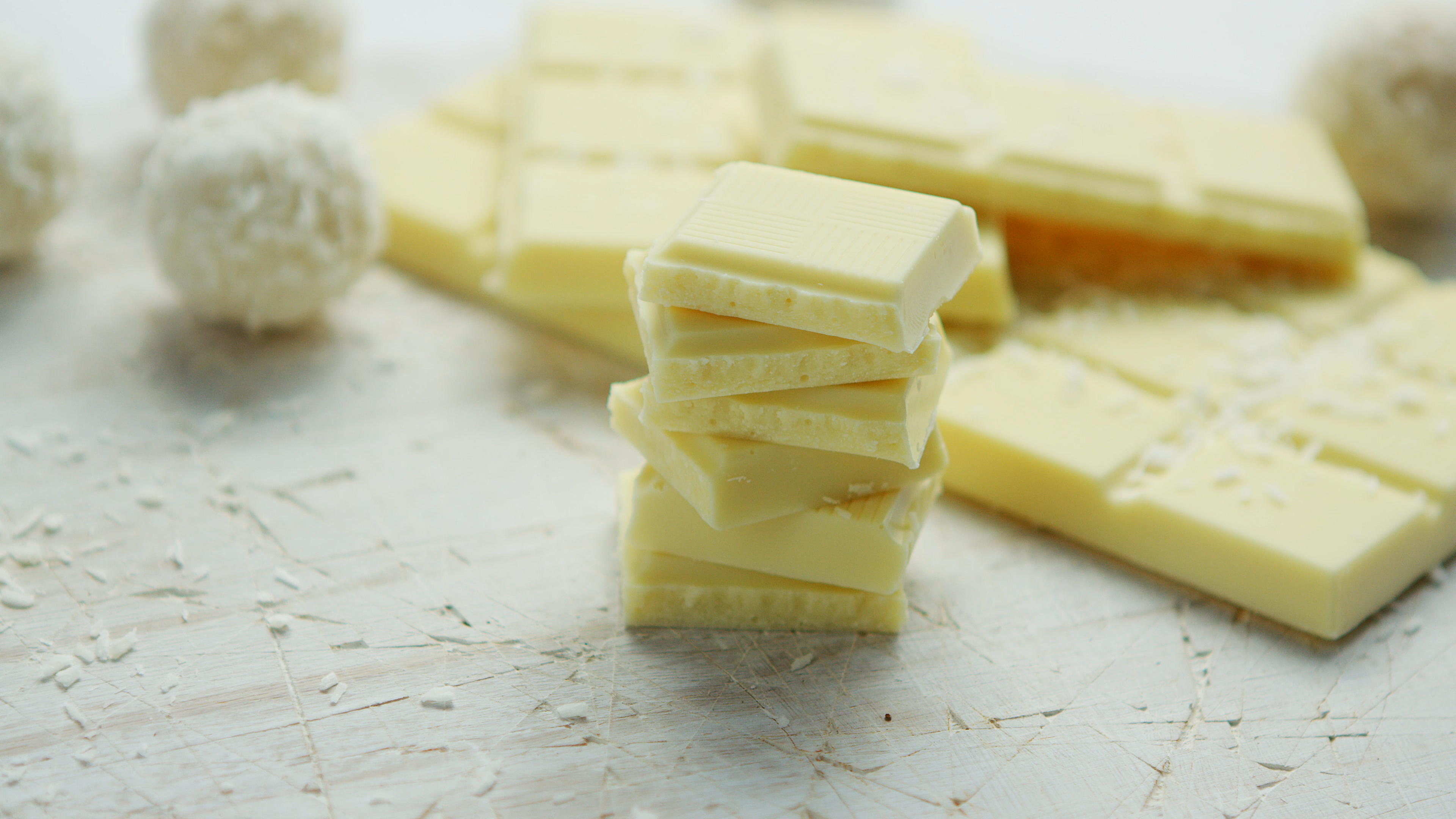Chocolate is a staple in many of our favorite desserts and treats, but do you know the difference between white chocolate and almond bark? While they offer delicious sweetness to any recipe, some key differences set them apart. In this blog post, we'll explore the nuances of white chocolate vs. almond bark so that you can make an informed decision when it comes time to pick your next treat. Read on for more information about these two tasty ingredients from Texas Hill Country's own chocolatiers.
White Chocolate

Photo by Jasmine Waheed / Unsplash
White chocolate is a type of chocolate made from cocoa butter, sugar, and milk solids. It does not contain cocoa solids like other chocolates, such as milk or dark chocolate. White chocolate was first created in the 1930s by Nestle in Switzerland. Because it lacks cocoa solids, white chocolate has a lighter color and milder flavor than other chocolates. The creamy, sweet taste comes from the cocoa butter, milk solids, and added vanilla. While considered chocolate, white chocolate contains no chocolate liqueur, and some countries have regulations on what can legally be labeled white chocolate.
Taste and Texture
White chocolate is a creamy, sweet confection from cocoa butter, milk, sugar, and vanilla. It has a distinctly smooth, rich, and velvety texture practically melts on your tongue. The flavor is milder than other chocolates, with subtle notes of vanilla rounding out the sweetness. When white chocolate is melted, its creamy texture becomes even silkier and more luxurious. Even when eaten straight out of the package in solid form, white chocolate maintains a pleasant mouthfeel and melts readily once chewed. The sweetness is tempered by the creamy cocoa butter, making white chocolate a delightful treat for any chocolate lover.
Uses in Recipes
White chocolate can make all sorts of desserts, including cakes, cookies, truffles, mousses, custards, ice creams, and more. It can also be used as a topping for cupcakes or brownies or melted down to make sauces and glazes for pies or pastries. White chocolate chips are often added to cookie dough for extra sweetness, too.
White chocolate is a creamy and sweet treat that has become increasingly popular recently. Its smooth texture makes it ideal for baking and decorating, while its subtle flavor adds a special touch to many recipes. Now, let's explore the world of almond bark.
Almond Bark

Photo by Irina Iriser / Unsplash
Almond Bark is a candy coating made from sugar, vegetable oil, and almonds. It has been around since the 1950s when confectioners first developed it as an alternative to chocolate. Almond bark has a sweet flavor with a crunchy texture from the almonds, making it distinct from other types of candy coatings.
The oil and sugar provide a smooth, creamy base, while the toasted almonds give each piece a delightful crunch. Almond bark can be flavored with vanilla or other extracts to complement the nuts. It is popular around holidays when it is used to coat and decorate cookies, fruits, or candies.
Definition and Origin:
Almond bark is made by combining sugar, vegetable oil, and chopped almonds into a paste-like mixture, which is poured onto wax or parchment paper to cool and harden. The result is a thin sheet of almond bark that can be broken into pieces for use in recipes or melted down for sauces or glazes.
To make almond bark, the sugar and oil are heated together until combined, and then the almonds are stirred in until evenly distributed throughout the mixture. The liquid is poured out in a thin layer to cool quickly into a solid sheet. Once hardened completely, the almond bark can be broken into irregular pieces or chopped neatly into uniform chunks. Melting the cooled almond bark creates a smooth, pourable liquid that can coat fruits or desserts or be used as a nutty glaze.
Taste and Texture:
Almond bark has a sweet flavor with hints of nuttiness from the almonds, giving it its unique taste. Its texture varies depending on how thickly it’s applied; if spread thinly, almond bark will have more airy crunch, while thicker applications will create denser chunks with larger pieces of nuts throughout.
Almond bark can coat candies such as truffles or caramels, giving them an extra layer of sweetness and some added crunchiness from the nuts. It can also be melted down to create sauces for ice cream sundaes or glazes for cakes and cookies; add some butter or heavy cream to help thin out the consistency so it is easier to work with.
Almond bark is a great addition to any recipe, offering a unique flavor and texture that white chocolate can't match. Now, let's look at how the two compare regarding taste, texture, and recipe uses.
Comparison of White Chocolate vs. Almond Bark
White chocolate and almond bark are popular candy coatings in baking and cooking recipes. Almond bark and white chocolate have a sweet flavor but differ in taste and texture. White chocolate is creamy and smooth with a mild sweetness, while almond bark has a crunchy texture due to almonds adding an extra layer of sweetness.
We don't use almond bark at Hill Country Chocolate, but we recognize that for home chefs, it can be an easy alternative to chocolate because of its simplicity. Regarding recipe uses, white chocolate can be melted down as icing or glaze on cakes or cupcakes. It can also be used as a coating for truffles or other confections. Almond bark is often used as an outer coating for chocolates, cookies, candies, nuts, fruits, and more. It’s also commonly used to make clusters by combining different ingredients, such as marshmallows or pretzels, with the melted almond bark before setting it into shapes like bars or balls.
So, what to pick? Almond bark or white chocolate, remember, white chocolate's distinct flavor and creamy texture lend themselves well to desserts like truffles and fudges. On the other hand, almond bark's affordability and versatility make it an attractive option for coating treats and adding a chocolate-like touch to your creations.
Frequently Asked Questioned about White Chocolate vs. Almond Bark
Q: What is the difference between almond bark and white chocolate?
A: Almond bark is a confectionary coating made with vegetable fats, while white chocolate is made with cocoa butter.
Q: Can almond bark be a substitute for white chocolate?
A: You can substitute almond bark for white chocolate in some recipes. Remember that if chocolate is the predominant flavor profile, it will not have the same flavor and texture compared to quality white chocolate. It is best used as a coating.
Q: What does almond bark taste like?
A: Almond bark has a sweet and slightly nutty flavor.
Q: Can I use almond bark instead of milk chocolate?
A: Almond bark can be used as a coating instead of milk chocolate, but if chocolate is the predominant flavor, you might be disappointed.
Q: How do I melt white chocolate?
A: To melt white chocolate, chop it into small pieces and heat it in a microwave-safe bowl for 10 to 30 seconds, stirring until melted.
Q: What is the difference between almond bark and real chocolate?
A: The main difference is that almond bark does not contain chocolate liquor, an essential ingredient in real chocolate to provide flavor.
Q: Can I use candy melts instead of almond bark or white chocolate?
A: Yes, candy melts can be used as a substitute for almond bark or white chocolate in certain recipes.
Q: What is almond bark made of?
A: Almond bark contains vegetable fats, sugar, flavors, and colors.
Q: Are almond bark and white almond bark the same thing?
A: Yes, white almond bark is almond bark that has been tinted white.
Q: Does white chocolate melt like regular chocolate?
A: Yes, white chocolate melts similarly to regular chocolate.
Conclusion
In conclusion, white chocolate and almond bark are popular treats with different flavors and textures. White chocolate is made from cocoa butter, sugar, milk solids, and vanilla. In contrast, almond bark is made from sugar or corn syrup, vegetable oil or shortening, almonds or other nuts, and flavorings.
While both can be used for baking purposes, such as coating cookies or making truffles, they also make great snacks on their own; when comparing white chocolate vs. almond bark, it's important to consider the flavor profile you're looking for to determine which one will best suit your needs.
Come to the Texas Hill Country and indulge in delicious true white chocolate. Our chocolates are handmade with love, giving you a unique taste that will surely please your palette! Enjoy pairing our creations with fine wines of the region for an unforgettable experience. Don't miss out on this special treat - come visit us today!




